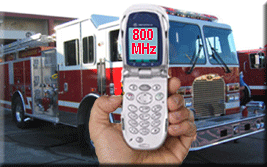|
Nextel 800 MHz rebanding set to begin this month in three-year project
June 1, 2005 – The Federal Communications Commission’s 800 MHz band reconfiguration will begin towards the end of the month, according to the FCC’s Wireless Telecommunications Bureau. Beginning June 27, a three-month voluntary negotiation period will begin for licensees to negotiate with Nextel Communications, followed by a three-month mandatory negotiation period.
Public safety departments have been anxious to see the rebanding process begin, which could take up to three years. The FCC's decision to reconfigure the 800 MHz spectrum, separating the incompatible technologies of public safety and commercial operations solves the pressing problem of radio interference at 800 MHz and provides additional spectrum for the future needs of first responders.
The massive project will be completed in phases entitled as waves with licensees in the following states being included in Wave 1 of the rebanding. Wave 2 will begin October 23; Wave 3, January 3, 2006, and Wave 4, April 3, 2006. National Public Safety Planning Advisory Committee (NPSPAC) regions are being used to administer an orderly reconfiguration of the 800 MHz band.
|
NPSPAC Regions Assigned to Wave 1
|
|
NPSPAC
Region
|
Region Description
|
|
6
|
California (Northern)
|
|
7
|
Colorado |
|
8
|
NY City area (NY, NJ, CT.) |
|
11
|
Hawaii |
|
13
|
Illinois (except Southern
Lake Michigan counties) |
|
14
|
Indiana (except Southern
Lake Michigan counties) |
|
19
|
New England |
|
20
|
Maryland, Northern VA, DC |
|
27
|
Nevada |
|
28
|
Eastern PA, DE, Southern
NJ |
|
35
|
Oregon |
|
41
|
Utah |
|
42
|
Virginia |
|
45
|
Wisconsin (except Southern
Lake Michigan counties) |
|
54
|
Southern Lake Michigan
(MI, WI, IL,IN) |
As part of the plan, the FCC has frozen applications in these areas of license applications within 70 miles of Wave 1 areas until February 8, 2006.
The FCC selected a Transition Administrator to serve as an independent third party. Law firm Squire-Sanders-Dempsey L.L.P., consulting firm BearingPoint, and Baseline Telecom comprise the team.
Nextel is required to resolve the interference problems public safety was experience because the carrier’s systems were interleaved with the first responders. For alleviating the problem Nextel will get 10 megahertz of G block spectrum in the 1.9 GHz band.
To ensure that Nextel does not realize any windfall gain, the FCC is requiring Nextel to pay into the US Treasury the difference between the value of the spectrum it is receiving ($4.86 Billion) and the sum of (1) the net value of spectrum rights that Nextel is relinquishing to public safety, CII, and other 800 MHz band licensees ($2.059 Billion); (2) the actual cost of 800 MHz band reconfiguration; and (3) costs incurred by Nextel to clear the 1.9 GHz band, less any reimbursed expenses. The FCC has required Nextel to provide irrevocable letters of credit in the amount of $2.5 billion to ensure payment of the costs of the reconfiguration.
- Licensees currently in the 806-809 MHz/851-854 MHz band (“Channels 1-120”) will be relocated.
- NPSPAC licensees currently in the 821-824 MHz/866-869 MHz band will be relocated.
- Public safety systems currently operating in the newly created “Expansion Band” at 815-816 MHz/860-861MHz will be relocated unless they elect otherwise.
- EA licensees who qualify and wish to operate ESMR systems may elect to relocate into the “ESMR Band” at 817-824 MHz/861-869 MHz.
- Licensees operating below 817 MHz/862 MHz may elect to relocate to the “Guard Band” at 816-817 MHz/861-862 MHz.
- All licensees may request to make voluntary relocations during the 800 MHz reconfiguration under certain circumstances.
- There is a slightly different 800 MHz band plan for certain areas in the Southeastern United States (sometimes known as the “Appendix G area”). In these affected areas, licensees operating at 812.5-817 MHz/857.5-862 MHz may also be required to relocate.
- Licensees generally operating within 110 km (68.4 miles) of the Mexican border and 140 km (87 miles) of the Canadian border may also need to reconfigure. Details regarding border area reconfiguration requirements will be determined in the future based on ongoing international negotiations related to the use of that spectrum.
|